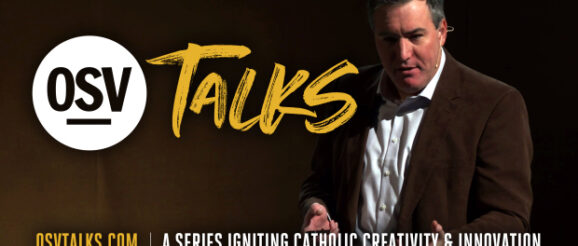OSV Talks: Why the Church needs “inefficient innovation”

There’s an urgent need for a personal, relational approach in modern-day missionary discipleship.
Years ago, my then-boyfriend gave me the best surprise for Valentine’s Day, and accidentally revealed a needed strategy for evangelization.
My boyfriend was not Catholic at the time. Our relationship was reaching a point when marriage was on the horizon, but as devout Christians, we worried that our religious differences would be an obstacle.
He happened to work for a Catholic archdiocese at the time (a whole story in itself!), and unbeknownst to me, was digging deep into Catholic teachings on his own. He had been reading books of apologetics and meeting with a priest friend to ask questions.
At some point, he realized that becoming Catholic wasn’t something he was considering for my sake, but what he truly wanted as well. So on Valentine’s Day, he gave me the news: He’d decided to convert.
We were both overjoyed, but Easter — when new converts typically enter the Church at the Vigil Mass — was a mere 7 weeks away. It was far too late for him to join an RCIA program, all of which had started months before.
Would he have to wait over a year to become Catholic, even though he was ready and wanting to enter the Church right away, all because he missed joining RCIA?
This kind of dilemma is at the heart of a wise and inspiring reflection from Jason Shanks, President of OSV Institute, shared in his OSV Talk called “The Inefficient Innovator.”
The video is one in a series of OSV Talks, which shine a light on creative means of evangelization, springing from the wisdom and deep prayer that energize these approaches. The talks, which are similar to TED Talks but with a Catholic focus, are free and available for anyone to watch at OSVTalks.com.
In his reflection, Shanks explores why prioritizing efficiency is not always the best way to evangelize. As President of OSV Institute, he works with apostolates, parishes, and dioceses, “primarily in helping them fund the work that they’re doing,” he said.
Innovation does not mean changing any aspect of Church teaching or tradition, but rather refers to “how we reach out, how we engage in new culture and new generation,” he said. The Church needs what St. John Paul II called new “ardor, methods and expression” of evangelization.
This need for innovation, however, calls for a kind of prudent inefficiency. While efficiency is critical for many undertakings, it’s not always wise when the mission is leading souls to Christ.
Evangelization, instead, calls for a relational and person-centered approach. In fact, “our efficient systems may be marginalizing and keeping people on the periphery,” Shanks said.
He gave the example of an experience he had many times while leading marriage preparation at a parish.
This concern is exactly what my boyfriend and I faced all those years ago. As Shanks put it, asking an eager convert-to-be to wait all that time before entering the Church can be like saying, “Let’s keep the Holy Spirit at bay while we structure this in a certain way.”
Instead, he calls for a holy urgency, imitating the urgency the disciples showed in Scripture. “We need to be inefficient innovators now,” he says.
Providentially, all those years ago, we found a holy priest who is the kind of “inefficient innovator” Shanks describes. After meeting with the priest several times to ensure his preparation, my boyfriend was able to enter the Church that Easter.
The grace and gift of his conversion was glorious to witness. We married not long after, and we are forever grateful to that priest who saw past the efficient systems to accompany my husband through his conversion in a personal way.
This “inefficient” approach can have an impact that reverberates widely, as Shanks explains. He shares a number of other key insights about innovative evangelization in his talk.
Above all, he said, “my prayer for all of us is that we would have the a-ha moments, that we would be inspired from the OSV Talks to dream bigger, to put out in the deep, and to not be afraid.”
